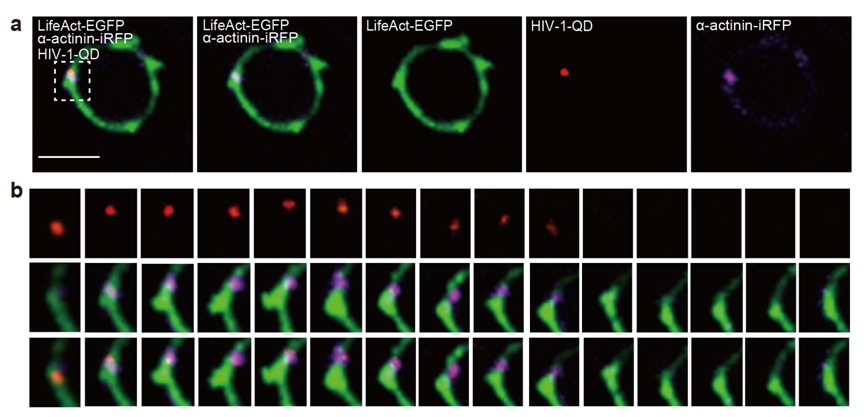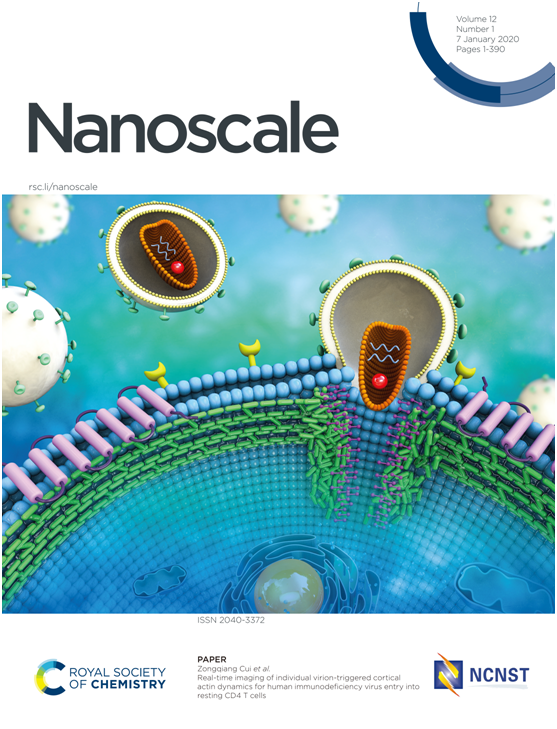Scientists clarify HIV entry into resting CD4 T cells
Date:14-01-2020 | 【Print】 【close】
CD4 T lymphocytes are the major targets of human immunodeficiency virus (HIV) infection. There is evidence showing that actin dynamics are critical for the HIV latent infection of resting CD4 T cells. However, the process of HIV entry and fusion in resting CD4 T cells has not been observed, and the involvement of actin dynamics in the HIV fusion process remains elusive.
In a recent study by the research group led by Prof. CUI Zongqiang in Wuhan Institute of Virology of the Chinese Academy of Sciences, using QD-based single-virus imaging, the scientists tracked the dynamic processes of HIV fusion and interactions with the cortical actin in resting CD4 T cells.
QD-encapsulated C–X–C chemokine receptor type 4 (CXCR4)-tropic HIV-1 (NL4-3) virion particles were constructed by site-specific labeling of the viral protein R (Vpr) during virus assembly and then used for imaging viral entry processes at the single particle level. The detailed scenarios, including the fine-scale temporal and spatial interactions of HIV with the cellular membrane and the cortical actin, were investigated using single particle imaging combined with inhibitor studies.
Their results reveal HIV entry into resting CD4 T cells via an α-actinin-mediated cortical actin rearrangement following viral fusion at the plasma membrane. In addition, α-actinin, an actin-binding protein that cross-links actin filaments, was found to play an important role in regulating actin dynamics during HIV entry. An α-actinin-derived peptide was developed to block viral entry and HIV infection.
In conclusion, by using QD-encapsulated fluorescent viral particles and single-virus tracking, the scientists reveal the process and mechanism of individual virion-triggered cortical actin dynamics for HIV entry into resting CD4 T cells. Their findings reveal an α-actinin-mediated cortical actin rearrangement for HIV entry, and identify an antiviral target as well as a corresponding peptide inhibitor based on HIV interaction with the actin cytoskeleton.
The study was published in Nanoscale entitled “Real-time imaging of individual virion-triggered cortical actin dynamics for human immunodeficiency virus entry into resting CD4 T cells”.
This work was supported by the Strategic Priority Research Program of Chinese Academy of Sciences, the National Key Research and Development Program of China, the National Natural Science Foundation of China, and the Youth Innovation Promotion Association of Chinese Academy of Sciences.

α-Actinin is involved in the actin dynamics during HIV-1 entry into resting CD4 T cells. Image by CUI Zongqiang

Contact:
CUI Zongqiang
E-mail: czq@wh.iov.cn
Wuhan Institute of Virology, Chinese Academy of Sciences, Wuhan 430071, China. (http://english.whiov.cas.cn/)